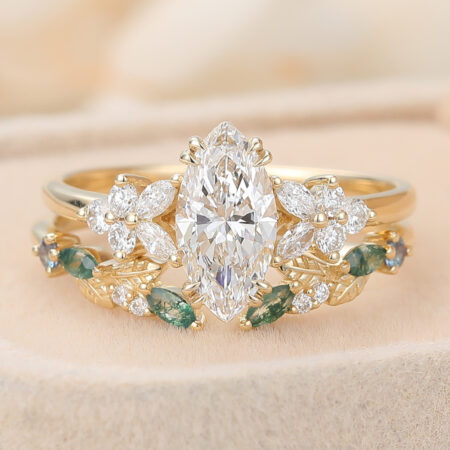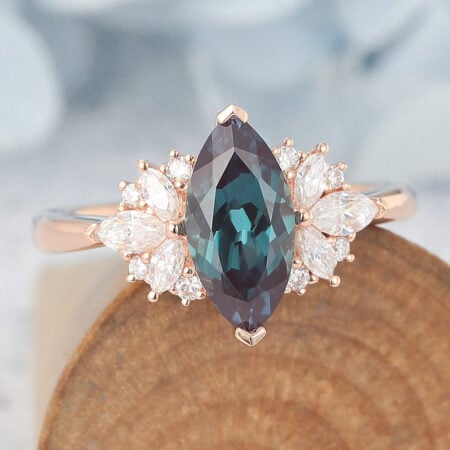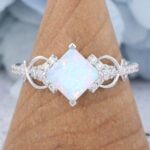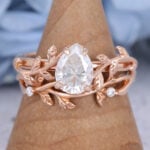What Is a Cluster Ring?
Elegant, bold, and full of personality—few styles make a statement quite like the cluster ring. Loved for its charm and sparkle, it continues to captivate modern and vintage lovers alike. Explore what makes a cluster ring so unique and how to choose the right one for you.
Definition of a Cluster Ring
Cluster rings are ring designs that set together multiple gemstones. These gemstones are usually small in size and can be of the same or different types, such as diamonds and colored gemstones. They are often arranged symmetrically around a center point, and common shapes include circles and geometric patterns. Through the combination of multiple gemstones, cluster rings visually amplify the sparkling effect, showing a stronger decorative impact and unique charm.
History and Origins
The history of the cluster ring can be traced back to the Georgian era in the 18th century, when jewelers began to use multiple small gems around the central main stone to create flower-like patterns, symbolizing luxury and romance. In the Victorian era, this design became more popular, often combining diamonds or colored gems to create complex and exquisite shapes for engagements, commemorations or dinner parties. Entering the Art Deco period in the 20th century, the style of cluster rings tended to be geometric and symmetrical, with neater lines, expressing a sense of modernity and artistry.
Key Design Features
The Georgian Era
During the Georgian Era (1714–1837), cluster rings were handcrafted with floral or rosette motifs, using small diamonds or foil-backed gems in closed settings. These rings often featured high-domed designs and intricate metalwork, reflecting the romantic and decorative tastes of the time.
The Victorian Era
A Victorian cluster ring often combined diamonds with richly colored gemstones like garnets, rubies, or sapphires. Designs became more expressive, featuring heart shapes, halos, and symbolic patterns. These rings reflected love, mourning, or status, and were set in yellow or rose gold.
The Edwardian Era
The Edwardian cluster ring showcased elegance and lightness, using platinum for the first time in fine jewelry. Rings featured intricate filigree work, pastel gems, and small diamonds arranged in lace-like designs. These delicate styles were favored by royalty and the upper class.
The Art Deco Era
An Art Deco cluster ring embraced bold symmetry, sharp lines, and modern contrast. Common materials included platinum, emeralds, sapphires, and black onyx. Rings were architectural in form, inspired by industrial progress, and signified a shift toward modern glamour and independence.
Contemporary Era
Today’s cluster rings blend vintage inspiration with modern flair. Designers experiment with asymmetry, mixed gemstone colors, and minimalist settings. Whether made with lab-grown diamonds or ethical materials, modern cluster rings appeal for their sparkle, affordability, and artistic individuality.

Types of Cluster Rings
Gemstone Cluster Rings
These rings feature grouped gemstones, either of the same type or in mixed colors. They’re often vibrant and expressive, with large cluster gemstone rings offering dramatic brilliance using sapphires, emeralds, or diamonds. This type suits those seeking a bold, luxurious statement.
Design-Based Cluster Rings
Cluster rings vary widely in design, from floral and vintage-inspired layouts to sleek, modern arrangements. These diverse cluster ring designs reflect changing fashion trends and personal taste, making them a versatile choice for both classic and contemporary jewelry lovers.
Centralized Cluster Rings
In this style, a central stone is surrounded by smaller gems, creating a symmetrical, radiant look. The coronet cluster ring is a traditional example, resembling a crown or halo. This timeless arrangement enhances the visual focus and is often chosen for engagement rings.
Occasion and Size-Based Clusters
Cluster rings are also categorized by their scale and use. While some are dainty and everyday-appropriate, others—like large cluster gemstone rings—are designed for special occasions, offering maximum sparkle and visual impact with carefully arranged stone groupings.
Advantages of Cluster Rings
- Bigger Visual Impact – Multiple stones create the illusion of a larger, more dazzling centerpiece.
- Cost-Effective – Smaller gems are more affordable, offering luxury at a lower price point.
- Unique Designs – A wide range of styles from vintage to modern makes them highly customizable.
- Symbolic Meaning – Multiple stones can represent family, unity, or special milestones.
- Versatility – Suitable for engagements, fashion, or special events, adapting to various occasions.

Cluster Ring vs Solitaire Ring vs Halo Ring, What’s the differences?
A cluster ring features multiple small gemstones arranged closely to create the illusion of a larger, more eye-catching design. It often offers vintage charm, added sparkle, and artistic variety in shapes and layouts.
A solitaire ring highlights a single gemstone on a plain band, drawing attention to the stone’s clarity and cut. It’s simple, timeless, and a popular choice for traditional engagement rings.
A halo ring surrounds a central stone with smaller diamonds, adding brilliance and emphasizing size. It combines classic elegance with extra sparkle, often used in modern bridal designs.
The main difference lies in stone arrangement and overall visual impact. Cluster rings use multiple stones for dramatic sparkle; solitaire rings focus on a single stone for elegance and minimalism; halo rings highlight one stone while boosting its presence with surrounding accents. Each style suits different tastes and occasions.
How to Choose the Right Cluster Ring?
When choosing the right cluster ring, consider your style, occasion, and budget. Diamond cluster cocktail rings are perfect for bold evening looks, while ladies diamond cluster rings with delicate designs suit everyday elegance or engagements. Pay attention to gemstone quality, metal type, and setting style to ensure the ring complements your wardrobe and personality. Custom or vintage-inspired designs can also add uniqueness and sentimental value.
Conclusion
A Cluster Ring blends beauty, brilliance, and vintage charm. Whether for daily wear or special occasions, it’s a timeless style that adds standout sparkle.
FAQs About Cluster Ring
What is a cluster ring and how is it different from other ring styles?
A cluster ring features several small gemstones grouped together, often forming a floral or geometric shape. Unlike solitaire rings that use one main stone, cluster rings create a larger visual impact through multiple stones.
Are diamond cluster rings tacky?
No, diamond cluster rings are not tacky. Their style depends on design and quality—well-crafted cluster rings can be elegant, vintage-inspired, or modern. They offer eye-catching sparkle and are widely accepted in both fashion and fine jewelry.
Are ladies diamond cluster rings good for engagement?
Absolutely. Ladies diamond cluster rings offer vintage charm and extra sparkle, often at a more affordable price than single large diamonds. They’re perfect for unique, elegant engagement ring alternatives.
Can I resize a cluster ring?
Most cluster rings can be resized, but the process depends on the band material and setting. It’s important to work with an experienced jeweler to protect the stones during resizing.
What metals are best for diamond cluster rings?
White gold, platinum, sterling silver and yellow gold are popular choices. Platinum offers durability, while gold allows more flexibility in color and price range for diamond cluster rings.



